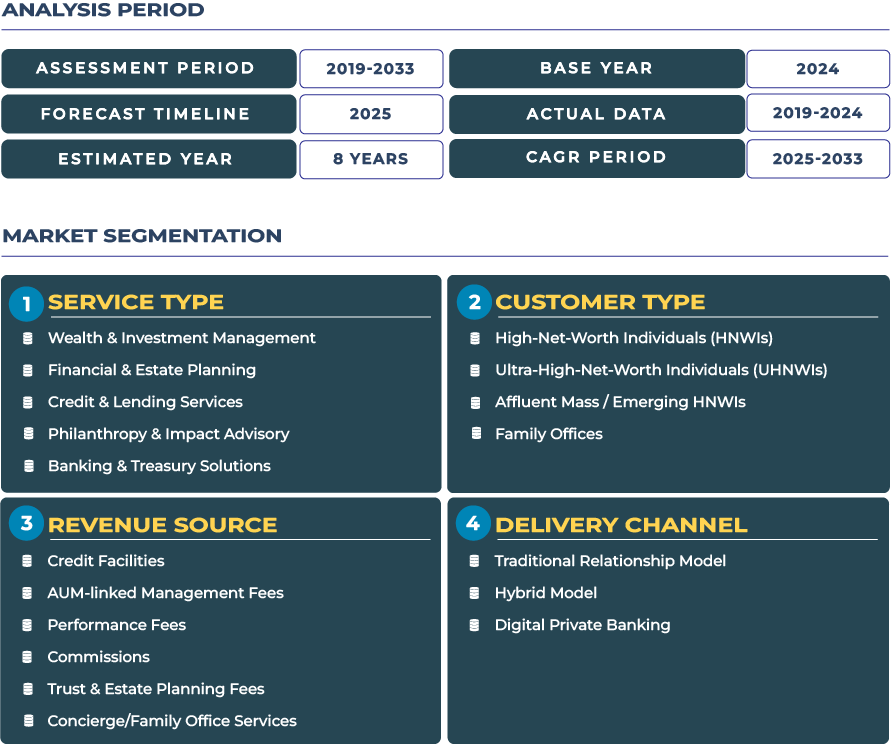Japan Private Banking Market Outlook: Navigating Aging Wealth and Succession Planning Reforms
Japan private banking landscape is entering a distinctive phase driven by demographic shifts and the imperatives of generational wealth succession. With an estimated market size of around USD 50.3 billion in 2025 and a projected expansion to approximately USD 73.4 billion by 2033, the sector is poised for a CAGR of roughly 4.9 % over the forecast period. The nexus of a retiring affluent cohort, rising demand for inheritance tax structuring, and the growing need for digital wealth interfaces has placed Japanese private banks under transformation pressure.
Note:* The market size refers to the total revenue generated by banks through various services.
As the “silver generation” of wealthy individuals passes on assets, family offices and successors are seeking integrated wealth & investment management, estate & legacy planning, credit & treasury solutions and philanthropic advisory. Wealth managers in Japan must therefore evolve beyond traditional deposit and investment services to offer advanced, generational-rich private banking ecosystems. Against a backdrop of low domestic yields, slow population growth and intensifying global competition, the ability to deliver holistic private banking in Japan mature market will be core to sustaining relevance and profitability.
Growth Catalysts & Structural Constraints: Key Drivers and Roadblocks in Japan Private Banking Industry
One of the primary drivers is the aging affluent population in Japan and the consequential need for succession planning. With one of the world’s most pronounced ageing demographics, affluent individuals are seeking trust structures, inheritance planning and cross-generational wealth strategies to preserve family capital. Secondly, institutional savings and elevated household investable assets offer private banks a solid foundation to expand advisory services beyond traditional deposit models. Finally, the innovation in technology-mobile wealth platforms, digital relationship management and AI-driven portfolio solutions-is opening the door to broader penetration of private banking services, especially among younger clients and in urban centres.
However, several headwinds remain. Low yield and limited return prospects in domestic fixed income challenge asset-management models in private banking, tightening margins and driving greater pressure on fees. Demographic decline means an increasingly narrow pool of next-gen wealth in certain regions. Risk-aversion among Japanese affluent individuals also slows adoption of more diversified or alternative-asset portfolios, complicating product-differentiation efforts. Furthermore, global private banking players targeting Japan must adapt to local wealth-behaviour idiosyncrasies- for example, high real-estate exposure and preference for conservative asset allocation-which adds complexity and cost to market entry.
Trend-Vectors & Opportunity Frameworks: AI-Retirement Planning, ESG Integration and Digital-Wealth Interfaces in Japan Private Banking Market
Japan private banking field is being shaped by several notable trends. AI-powered retirement and wealth-transition planning tools are gaining traction: advisors are deploying algorithms to model legacy scenarios, asset decumulation strategies and tax-efficient retirements for clients in their 50s and 60s. Further, ESG integration is picking up pace among Japanese wealthy-though slower than Western markets-and private banks are launching sustainable-wealth products, impact-investing advisory and carbon-linked portfolios. Moreover, digital‐wealth interfaces-mobile apps, robo-advisory, e-sign trust structures-are becoming baseline offerings, enabling firms to engage younger affluent clients and streamline legacy-planning workflows.
Opportunity frameworks. For private banks in Japan, significant opportunities lie in developing retirement-linked banking solutions that integrate wealth draw-down strategies, healthcare financing, legacy planning, and family governance. Another area of growth is the creation of ESG-focused products that align with clients’ increasing interest in sustainable investments through tailored advisory, customised portfolios, and impact reporting mechanisms. Additionally, the adoption of digital service automation can help reduce operational costs, improve client experience, and expand access to wealth management solutions for the mass affluent segment. Institutions that align with these strategic frameworks will be well positioned to thrive in Japan’s evolving private banking landscape.
Competitive Landscape: Platform-Oriented Strategies and Market Positioning in Japan Private Banking Sector
The competitive environment in Japan private banking market is characterised by a mix of large domestic financial groups and growing digital-wealth challengers. A key player, Nomura Holdings, has publicly announced a strategic focus on nearly doubling its pre-tax profit over seven years by elevating its wealth-management business and expanding into private banking for business owners and professionals. Firms are deploying strategic levers such as tiered segmentation (mass affluent, HNWI, UHNW), mobile-first private banking platforms, regional branch networks, and wealth-service alliances. In this environment, the definition of private banking is expanding-it now must integrate wealth & investment management, estate & legacy planning, credit & lending services, philanthropy & impact advisory and banking & treasury solutions in a seamless client-journey. Leadership will go to those institutions that combine legacy trust capability with modern digital service, deep advisory and global connectivity.







